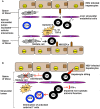NK cells: a double-edged sword in chronic hepatitis B virus infection
- PMID: 23459859
- PMCID: PMC3585438
- DOI: 10.3389/fimmu.2013.00057
NK cells: a double-edged sword in chronic hepatitis B virus infection
Abstract
There is natural enrichment of NK cells in the human liver and this intrahepatic predominance underscores their potential importance in the control of infections with hepatotropic viruses such as hepatitis B virus (HBV). The contribution of innate components during chronic HBV infection has been a relatively under-investigated area. However, recent data have highlighted that NK cells are capable of exerting antiviral and immunoregulatory functions whilst also contributing to the pathogenesis of liver injury via death receptor pathways. We will present an overview of current knowledge regarding the complex biology of NK cells in the context of their antiviral versus pathogenic role in chronic hepatitis B as a clinically relevant avenue for further investigation.
Keywords: CD56bright; IFN-alfa; IL-10; NK cells; TRAIL; hepatitis B virus; interferon-gamma; liver damage.
Figures

References
-
- Ahlenstiel G., Edlich B., Hogdal L. J., Rotman Y., Noureddin M., Feld J. J., et al. (2011). Early changes in natural killer cell function indicate virologic response to interferon therapy for hepatitis C. Gastroenterology 141, 1231–1239, 1239.e1–1239.e2.10.1053/j.gastro.2011.06.069 - DOI - PMC - PubMed
-
- Balkow S., Kersten A., Tran T. T., Stehle T., Grosse P., Museteanu C., et al. (2001). Concerted action of the FasL/Fas and perforin/granzyme A and B pathways is mandatory for the development of early viral hepatitis but not for recovery from viral infection. J. Virol. 75, 8781–879110.1128/JVI.75.18.8781-8791.2001 - DOI - PMC - PubMed
Grants and funding
LinkOut - more resources
Full Text Sources
Other Literature Sources

